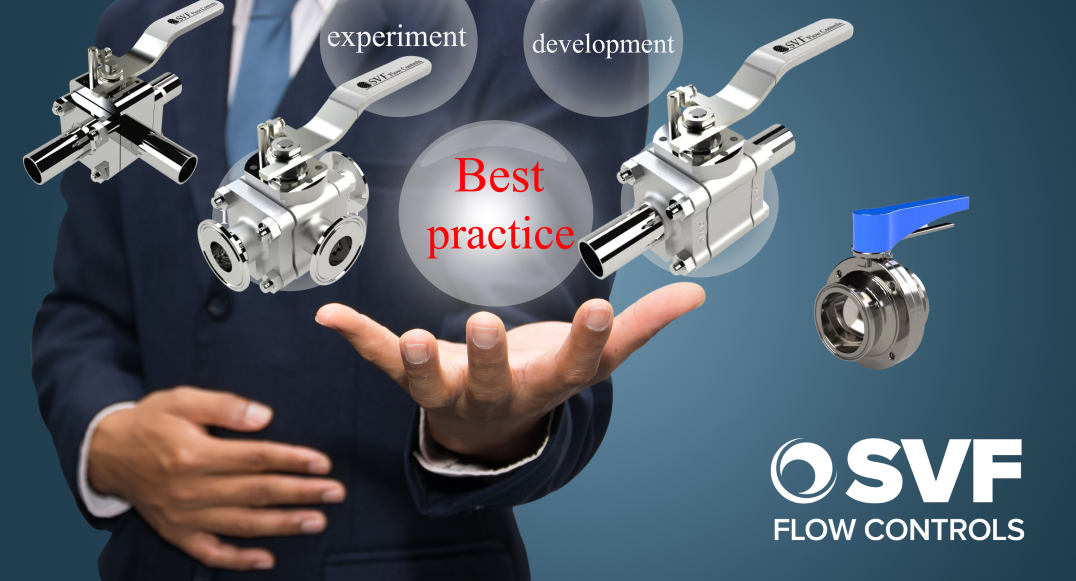Best Practices When Installing Valves for Pharmaceutical Applications
03.12.2025 | Industry News

Installing valves for pharmaceutical applications requires a unique approach to meet strict sanitary and regulatory standards. Unlike other industries, pharmaceutical valve installation prioritizes hygiene, precision, and compliance. In this blog, we’ll explore how pharmaceutical valve installation differs from other applications and highlight best practices to ensure optimal performance and compliance.
How Pharmaceutical Application Installations Differ:
1. Material Selection
- Pharmaceutical: Stainless steel, typically 316L and electropolished surfaces, PTFE or EPDM seals, and FDA-compliant materials.
- Other Applications: May use carbon steel, cast iron, or standard stainless steel with less focus on surface finish.
2. Installation Environment
- Pharmaceutical: Cleanroom or controlled environments to prevent contamination.
- Other Applications: Typically installed in standard industrial settings.
3. Valve Design Considerations
- Pharmaceutical: Sanitary diaphragm valves, ball valves or pinch valves to minimize dead space and bacterial growth.
- Other Applications: Standard ball, gate, globe, or butterfly valves with less concern for contamination.
4. Surface Finish & Cleaning
- Pharmaceutical: High-polish internal surfaces (Ra ≤ 0.4 µm), electropolished finishes, and CIP (Clean-in-Place) or SIP (Steam-in-Place) compatibility.
- Other Applications: Rougher finishes, often without CIP/SIP requirements.
5. Installation Practices
- Pharmaceutical:
- Orbital welding or sanitary clamps (Tri-Clamp fittings) instead of threaded or flanged connections to prevent crevices where contaminants can accumulate.
- Use of aseptic connections and gaskets rated for high-purity applications.
- Strict validation and documentation of installation.
- Other Applications: Standard welding, flanged, or threaded connections without extensive validation.
6. Regulatory Compliance
- Pharmaceutical: Must meet FDA, USP Class VI, ASME BPE, and cGMP standards.
- Other Applications: Compliance varies based on industry, often ANSI, API, or other industrial standards.
Some best practices to consider for Pharmaceutical Applications:
1. Choose the Right Valve Type
- Use sanitary diaphragm valves, ball valves, pinch valves, single use valves or butterfly valves designed for pharmaceutical applications.
- Ensure all materials (e.g., 316L stainless steel, PTFE, EPDM, or silicone seals) are FDA-approved and meet ASME BPE standards.
2. Ensure Proper Valve Orientation
- Diaphragm Valves: Install with the flow direction and pitch for full drainability.
- Ball & Butterfly Valves: Ensure the stem is in a position that allows full drainability when the system is cleaned.
3. Minimize Dead Space & Contamination Risks
- Avoid valves with cavities where bacteria or contaminants can accumulate.
- Install valves at proper slope or pitch for proper drainage.
4. Use Hygienic Connections
- Tri-Clamp (Sanitary Clamp) Fittings: Preferred for easy disassembly and cleaning.
- Orbital Welding: Used for permanent connections to maintain smooth internal surfaces.
- Minimize threaded connections, as they can harbor bacteria.
5. Ensure Proper Surface Finish
- Use 316L stainless steel materials with a surface finish of Ra ≤ 0.51 µm (20Ra) or
- Use electropolished 316L stainless steel with a surface finish or Ra ≤ 0.38 µm (15Ra).
- Verify surface finish using a profilometer or supplier documentation.
6. Implement CIP/SIP Compatibility
- Ensure valves can handle Clean-in-Place (CIP) and Steam-in-Place (SIP) procedures.
- Use self-draining designs to prevent residue buildup.
7. Maintain Proper Documentation & Compliance
- Keep Material Test Reports (MTRs) and certifications for all valve components.
- Ensure cGMP (current Good Manufacturing Practices) and ASME BPE compliance.
- Validate installation through pressure testing, flow testing, and sterility checks.
8. Conduct Leak & Integrity Testing
- Perform hydrostatic testing or bubble testing after installation.
- Check for leaks at seals, gaskets, and welded joints.
- Ensure proper torqueing of clamps and fasteners.
9. Train Personnel on Proper Handling & Maintenance
- Ensure installation teams follow strict sanitary handling protocols.
- Use clean gloves and lint-free wipes when handling valve components.
- Implement preventive maintenance schedules to check for wear and seal degradation.
When you're choosing pharmaceutical valves, it's worth going with a manufacturer that has the right setup—like cleanrooms and electropolishing stations—to ensure quality and compliance. SVF Flow Controls maintains an ISO 6 / Class 1,000 cleanroom, ensuring our valves are assembled and packaged in contaminant-free environments. Our complete range of pharmaceutical valves, including the CleanFLOW™ series, is designed to meet strict industry requirements. To learn more about SVF Flow Controls and our inhouse services as well as our line of pharmaceutical valves.

